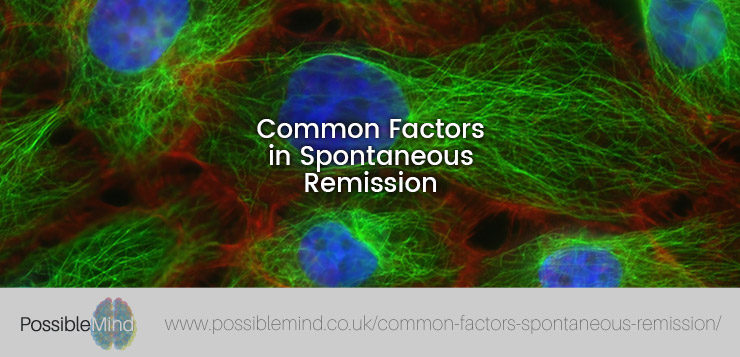Common Factors among Some of the Reported Cases of the Spontaneous Remission and Regression of Cancer after Acute Infections.
Abstract
An immunological mechanism has been suggested for some of the case reports of the spontaneous remission and regression of cancer after an acute infection [1]. The basic suggestion made is that two or more acute inflammatory responses are occurring at about the same time in these cancer patients. Furthermore, it is suggested that two or more acute inflammatory responses occurring at about the same time may negate the inhibitory effect of systemic inflammation on innate immunity. It is suggested that the activation of innate immunity cells (NK cells, Dendritic cells, etc.) in these cancer patients results in the spontaneous remission of cancer.
Introduction
Case 1
Spontaneous regression of metastatic melanoma after inoculation with tetanus-diphtheria-pertussis vaccine [2].
According to the authors the patient developed local and systemic febrile reaction that lasted two days after receiving the vaccine. Possibly an infection or an allergic reaction is occurring at the same time of vaccination. The vaccine is inducing an immune reaction. Also, the local and systemic febrile reaction is inducing an immune reaction. Afterwards the patient had a remission of melanoma without any signs or symptoms. Two separate immune reactions are occurring at about the same time.
Case 2
Remission of chronic lymphocytic leukemia after small pox vaccination [3].
Patient was revaccinated with small pox vaccine. A severe local reaction and generalized rash followed. Afterwards leukocyte count fell to normal and all evidence to CLL disappeared. The vaccine is inducing an immune reaction. Also, the generalized rash is inducing an immune reaction. Two separate immune reactions are occurring at about the same time
Case 3
Risk of BCG intralesional therapy: An experience with melanoma [4].
Patient had a severe allergic reaction to BCG which is inclusive of an acute inflammatory response. Also the bacterial effect of BCG induces an acute inflammatory response. According the authors it seems patient had an anaphylactic reaction and Arthus reactions. Afterwards the patient had a remission of melanoma without any signs or symptoms. Two separate immune reactions are occurring at about the same time.
Case 4
Complete remission of splenic marginal zone lymphoma after an acute flare-up of hepatitis B in a hepatitis B virus carrier [5].
Patient has chronic hepatitis B. HBs antibody is negative. HBs antibody becomes positive and patient has a flare-up of hepatitis B. Afterwards the patient had a remission of lymphoma without any signs or symptoms. Two separate immune reactions are occurring at about the same time.
Case 5
Immunotherapy with dinitrochlorobenzene (DNCB) for recurrent squamous cell tumor of conjunctiva [6].
According to the authors “A week later there was a marked spontaneous ‘flare’ response the site of application. The lesion exhibited weeping and marked induration. This response of delayed hypersensitivity persisted for more than five weeks”. Hypersensitivity response to DNCB subsides over a few days. Two separate immune reactions occurring at about the same time.
Case 6
Complete spontaneous remission of diffuse large B-cell lymphoma of the maxillary sinus after concurrent infection [7].
According to the authors the patient had pneumonia and Clostridium Difficile Toxin with fever. A short while afterward the patient had a remission of lymphoma without any signs or symptoms. Two separate immune reactions are occurring at about the same time.
Case 7
Spontaneous regression of hepatocellular cancer: Case report and review of the literature [8].
Patient had chronic hepatitis C infection, inflammation of the liver. Patient was admitted for pneumonia afterward patient had a remission of hepatocellular carcinoma without any signs or symptoms. Two separate immune reactions are occurring at about the same time.
Case 8
An unusual case of spontaneous remission of Hodgkin’s disease after a single cycle of COOP-ABV chemotherapy followed by infectious complications [9].
Patient had interstitial pneumonia then developed pancreatitis, inflammation in the pancreas. Afterwards the patient had a remission of Hodgkin’s disease without any signs or symptoms. Two separate immune reactions are occurring at about the same time.
Case 9
A man with spontaneous regression of non-Hodgkin lymphoma, hypergammaglobulinemia and infections caused by 2 herpes viruses, causality or coincidence [10].
Patient had cytomegalovirus (CMV) and reactivated chronic Epstein-Barr virus (EBV) infection. Patient had a regression of non-Hodgkin lymphoma. Two separate immune reactions occurring at about the same time.
Article is in Dutch, abstract in English
Case 10
11].
Patient had Streptococcus Facalis and Staphylococcus aureus infections. Patient had a regression of Gastric cancer. Two separate immune reactions occurring at about the same time.
Article in Spanish, abstract is in English
Case 11
Spontaneous regression of ovarian carcinoma after septic peritonitis; a unique case report [12].
Septic peritonitis is an inflammatory condition to microbial contamination. It appears patient had sepsis and inflammation of peritoneal. Two separate immune reactions occurring at about the same time.
Case 12
Spontaneous complete remission in a patient with acute myeloid leukemia and severe sepsis [13].
The culture of tracheal discharge was positive for enterobacter spp. and acinetobacterbaumanni. Blood culture results was klebsiella pneumonia. Three separate immune reactions occurring at about the same time.
Case 13
Spontaneous regression of pancreatic cancer with liver metastases [14].
Patient had chemotherapy complicated by mucositis, inflammation and ulceration of mucous membranes. Also, patient had two episodes clostridium difficile. Two separate immune reactions occurring at about the same time.
Case 14
Spontaneous regression of a pancreatic head mass and biliary obstruction due to autoimmune pancreatitis [15].
Autoimmune pancreatitis is the inflammation of the pancreas. Biliary obstruction is accompanied with infection. Two separate immune reactions occurring at about the same time.
Case 15
Carcinoma of head of pancreas with spontaneous regression [16].
Patient had acute cholangitis and pericholangitis, infectious hepatitis and a fever at admission of 100.6 °F. Inflammations plus an infection occurring at about the same time. Three separate immune reactions occurring at about the same time.
Case 16
Spontaneous regression of pancreatic cancer [17].
Patient had severe peritonitis an inflammation. Also patient had pneumonia an infection. Patient also had perforated duodenal ulcer which leads to infection. Two or three separate immune reaction occurring at about the same time. In this case the cancerous disease returned after a while.
Methods
Reports for the spontaneous remission or regression of cancer were searched for primarily through the medical literature. Afterwards were categorized by tissue of origin and also were categorized by factors common to the reports of spontaneous remission or regression of cancer (Acute infections, Rapid and steady growth, biopsy, corticosteroid, palliative surgery and palliative radiation therapy). Then the reports were compared to one another.
Results
The fever occurring prior to the spontaneous remission of cancer is Significant. When an acute inflammatory response occurs the local area becomes warm. When a few acute inflammatory responses occur at about the same time a mild rise in body temperature occurs. This mild fever is not due to the growth of infection it is an immunological response. When Coley’s toxin (bacteria that was not live) was used those instances that a fever occurred were more likely to be followed with a remission of cancer. In cases reports of spontaneous remission of cancer after an acute infection the fever prior to the spontaneous remission of cancer stands out and is also reported. Since, the case reports are live bacteria it is assumed the rise of fever is caused by the bacteria. This study is suggestive that two fever spike occurs. One caused by the combination of the acute inflammatory responses. The other caused by the growth of the bacteria. It is suggested that the fever caused by combination of acute inflammatory responses is what causes an activation of the immune system in cancer patients. Also, when a few vaccines (bacteria not alive) are given at about the same time there is a rise in body temperature.
A closer look at the reports of the spontaneous remission or regression of cancer after an acute infection indicates that two or more ACUTE INFLAMMATORY RESPONSES are occurring at about the same time. This seem to point to the direction that if a few mild acute inflammatory responses occur at about the same time it would be able to re-activate the immune system in cancer patients against the malignant growth. Some spontaneous remission of cancer seems to occur after a single acute infection accompanied by a low dose of a corticosteroid [18].
It is well known that Coley’s toxin was very effective against certain types of cancer. It should be noted the toxin was repeated many times but due to it potent ability to stimulate the immune reaction the frequency of such treatment was delayed for more than one day. Coley’s Toxin could not be repeated at about the same time because of its severe immunological response. Coley’s Toxin had to be repeated soon enough to have an additive effect with the previous shot of Toxin but not too soon to induce such massive immune response that the host could not tolerate. It seems Coley’s Toxin success depended on correct timing as much as on the potency of Coley’s Toxin itself.
Acute infections (mild acute inflammatory responses) may cause a spontaneous remission of cancer as reported by the many case report in the medical literature. Also, severe acute inflammatory responses induced by Coley’s Toxin resulted in the remission of the malignant disease. One may conclude that the high potency of an agent to induce a severe acute inflammatory response may activate the immune system against the malignant growth, but also a combination of a few mild acute inflammatory responses within a short time frame may also activate the immune system against malignant growth.
Discussion
Researchers have been baffled by the many reports of the spontaneous remission of cancer, a complete and total disappearance of all signs and symptoms of cancer after an acute infection [1]. The general appearance is that a single infection (acute inflammatory response) is at work. This study is suggestive that a closer look at these reports would reveal that two or more acute inflammatory responses are occurring at about the same time. In addition, at other times an acute infection could be accompanied with an element (allergic reaction, inflammation, etc.) inducing an acute inflammatory response. This study is suggestive of a discovery that the spontaneous remission of cancer after an acute infection is due to the combination of two or more acute inflammatory responses (acute infections, allergic reaction, inflammation, etc.) occurring at about the same time. The single acute infection noted in the reported cases is accompanied by another infection or any other thing that might induce an acute inflammatory response. It seems this combination of acute inflammatory responses occurring at about the same time has the ability to overcome a suppressed innate immunity and induce a remission of cancer. If correctly explained immunization of cancer patients against cancer becomes possible.
Pancreatic cancer is very aggressive and inflammation plays an important role in its progression. The world literature may five or a few more reported cases of a spontaneous remission or regression of pancreatic cancer. Four of which are referenced in this paper. Two common factors may be identified among these four case reports. First, inflammation is present and separate from the inflammation induced by the pancreatic cancer. Secondly, an infection independent of the inflammation present at about the same time.
Inflammation induced by the pancreatic cancer is the power house for its growth. Yet, if there is a second inflammation going on at about the same time it may lead to the regression or remission of pancreatic cancer. One may wonder what would be the relationship between the two inflammations. Are the resources or mediators of inflammation being depleted so that the pancreatic cancer cannot have an immune-suppressive effect by inducing inflammation. It is noteworthy that there are a few case reports of the spontaneous remission of hepatocellular carcinoma after portal vein thrombosis [19]. The portal vein carries blood to the liver and the liver produces inflammatory proteins.
It is suggested that if two or more mild acute inflammatory responses are induced at about the same time, then the immune system in cancer patients becomes activated against the malignant growth and a remission follows. if the host has not been previously exposed to the agent inducing an acute inflammatory responsepossibly a better immunological response would be obtained.
An acute inflammatory response activates innate immunity (Dendritic cells, NK cells, etc.).
Innate immunity act as a surveillance mechanism against damaged cells (virus infected cells cancer cells, etc.). Dendritic cells are the most potent antigen presenting cells.
During malignant growth innate immunity cells (NK cells, Dendritic cells, etc.) are inhibited from removing the malignant growth so that the malignant growth may take place. It appears that this inhibition is due to the inability of the acute inflammatory response in activating innate immunity cells and it might be by passed by a steady activation of an acute inflammatory response (a few acute inflammatory responses occurring at about the same time). This seems to account for more than one acute inflammatory response just prior to the spontaneous remission of cancer after an acute infection.
Conclusion
1. It appears that if a few acute inflammatory responses are induced at about the same time a remission of cancer may occur. A simple way to induce a few acute inflammatory responses at about the same time is by the use of non-live vaccines. This study is suggestive that if a cancer patient is injected with a few non-live vaccines Tdap (Tetanus, Diphtheria, Pertussis), Meningococcal, Pneumococcal, Hepatitis A, Hepatitis B, etc. all at about the same time and if a mild fever occurs afterwards than a remission of the cancer will possibly occur. As the number of the non-live vaccines administered at about the same time increase so does the chances of the mild fever occurring. The mild fever is indicative of an immune reaction. The fever is also reported in many case reports of the spontaneous remission of cancer after an acute infection.
2. Furthermore, it appears that a remission or regression of cancer might occurs if a mild acute inflammatory response is induced by an endotoxin and is accompanied by a severe acute inflammatory response induced by an Allergic Reaction [1–5]. The allergic response might be considered as a delayed hypersensitivity response. In other words an acute inflammatory response is superimposed on a delayed hypersensitivity response. It is known that delayed type hypersensitivity responses are generally depressed in cancer patients particularly if the site is close to a growing malignant tumor. One might make the suggestion that an acute inflammatory response superimposed on a delayed type hypersensitivity response in cancer patients may reactivate a full blown delayed type hypersensitivity response in cancer patients and resulting in a remission or regression of cancer. Tuberculin skin test might be used to induce a delayed type hypersensitivity response.
3. In addition, it appears a remission or a regression of cancer may occur if an inflammation is accompanied by an infection [7,8,11,13–16]. The possible explanation might be that the inflammation is competing for inflammatory mediators with the systemic inflammation induced by the malignant growth, therefore a depletion of inflammatory mediators would suppresses systemic inflammation induced by the malignant growth thereby negating the immuno-suppressive effects of systemic inflammation induced by the malignant growth. On the other hand the infection is activating an immune response against the infection and the malignant tumor. Furthermore, it seems if the inflammation does not deplete inflammatory mediators it could be enhancing the malignant growth. Pancreatic cancer is very aggressive and very dependent on inflammation induced by the tumor and readily susceptible to remission or regression in the absence of inflammation induced by the tumor.
4. Possibly a shift in inflammation is occurring. The host produces inflammation (acute) to protect itself from damage cells, virus infected cells, cancer cells, etc. The tumor produces inflammation (systemic) (immune eclipse) [20] to protect itself from the host. When a few immune reaction (acute inflammatory responses, allergic reactions, inflammation, etc.) are occurring at the about the same time there is possibly a shift in inflammation from protecting the tumor from the host to protecting the host from the tumor. Thereby a regression or remission of the malignant growth. It seems a low dose of synthetic corticosteroids such as Dexamethasone, Prednisone or Cortisone facilitate the shift of inflammation from protecting the tumor from the host to protecting the host from the tumor.
Caution
Medical Supervision Required. A patient condition may preclude use of non-live vaccine. There is no proof that the suggested experimental treatment would work.
It is based on a hypothesis suggesting an immunological mechanism for the spontaneous remission of cancer after acute infections. Therefore, suggesting an experimental treatment for cancer patients.
Disclaimer
No content on this site regardless of date should ever be used as a substitute for direct medical advice from your doctor or other qualified clinicians.
Author requesting anyone with any information regarding non live vaccines and cancer to send an email to cancernonlivevaccine [at] yahoo [dot] com
This study and article was originally published on April 25th 2019 at www.clinmedjournals.org.
If you like this post you will also enjoy:
- Imagery Can Help You Recover from Injuries and Illness – Learn Mind Power With John Kehoe.
- Mind Power and Belief for Recovery and Healing.
- How Athletes Recover Quicker Using Mind Power.
- The Healing Power of Illness Book Overview.
Further Reading:






